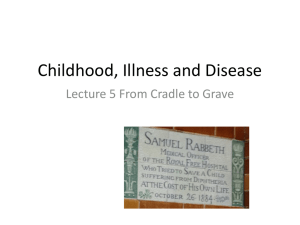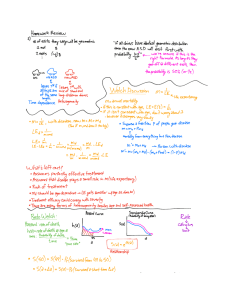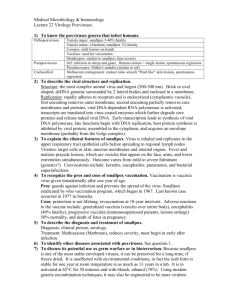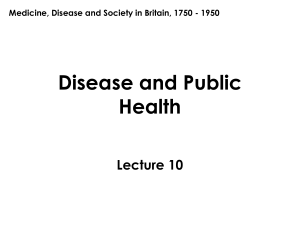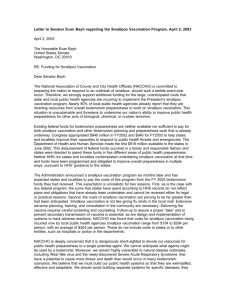Childhood, Illness and Disease Lecture 5 From Cradle to Grave
advertisement
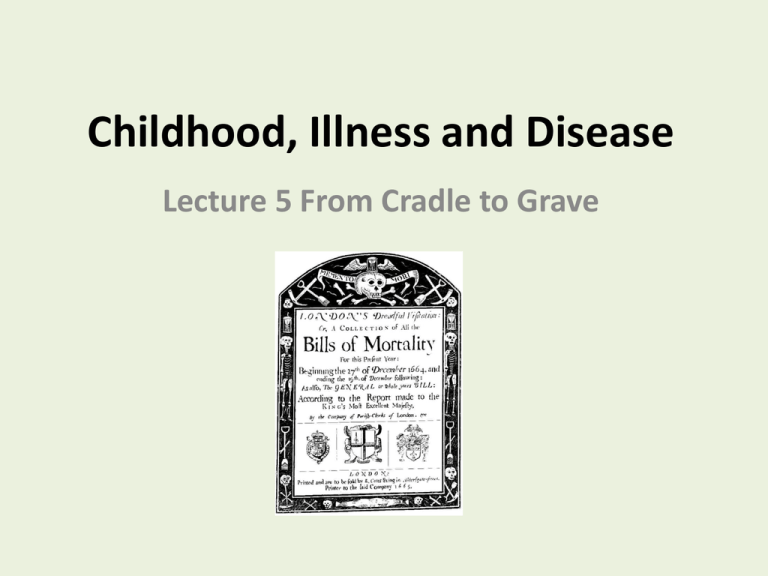
Childhood, Illness and Disease Lecture 5 From Cradle to Grave Disease, mortality and the state • Disease impacts on populations, but also economy, state and cultural beliefs and practices. • State involvement in public health and disease regulation – includes quarantine, vaccination, public health measures, establishment of infectious disease hospitals. • Much positive (there is an improvement narrative here), but also marks state interference in individual rights with regard to health – and often involves compulsion. Topics • Disease, morality and historical interpretation • Public health responses to disease Lecture Outline 1. Disease, mortality and demography 2. Disease and its prevention • Smallpox – inoculation and vaccination • TB – sanatoria and nutrition • Cholera – public health and sanitary reform Definitions: • Epidemic = prevalent in waves, short-term; attacks populations indiscriminately. • Endemic = regularly or usually found among the population. • Pandemic = global outbreak of disease in limited time period. L0032951 : Wellcome Library, London "The Diagnosis of Smallpox", Ricketts, T. F, Casell and Company, 1908 Plate XV, Young boy with smallpox showing the distribution of smallpox scabs before and after falling from the body. Smallpox • Smallpox – major killer, and children very vulnerable. Viral sickness – spread by droplet infection. Also caused male infertility as well as high mortality, so major check on population. • Smallpox endemic and epidemic – vaccination only arena where significant decline in death rates due to direct medical intervention up until late 19th century (McKeown thesis). • Inoculation – Lady Mary Wortley Montague (1720 son inoculated in Constantinople). Edward Jenner (1749-1823) • Vaccination developed in 1796. • Observed that milkmaids and stockmen rarely developed smallpox. • Inoculated James Phipps with cowpox and 6 weeks later with smallpox – proved immunity to smallpox. Remarkable feat of empirical medicine. • Pamphlet An Inquiry into the Causes and Effects of Variola Vaccinae (1798). 1801 100,000 people vaccinated. National Vaccine Establishment 1808. Edward Jenner vaccinating patients in the Smallpox and Inoculation Hospital at St. Pancras: the patients develop features of cows. Coloured etching after J. Gillray, 1802 Vaccination implementation • 1840 Vaccination Act – first move into state medicine • Further legislation 1850s, 1860s • 1853 Act vaccination of infants compulsory before age of 3 months • Public Vaccinators 187071; fine of 25s if parents refused to vaccinate children • Children refused admission to school if not vaccinated Anti-vaccination • Many of poor opposed vaccination – objected to compulsion, association with Poor Law and to procedure itself. • Anti-Vaccination League 1866 – ‘conscientious objectors’. Campaigns in many towns e.g. Leicester, Dewsbury, Brighton. • However, opposition died down and vaccination widely introduced. Last major outbreak smallpox 1902-03, and 1907 repeal of compulsory vaccination. Tuberculosis • Major killer in the 19th century (endemic) • 1839 TB was responsible for 17.6% of all deaths in England and Wales • 1848-55 largest single cause of death – 354,542 • In the early 20th century it remained the most prominent chronic illness – 75,000 deaths per year • Widely thought to be hereditary in 19th century and associated with bad working and living conditions and vice • Spread through close personal contact – important to remove sufferers from their environment – TB sanatoria and open-air school movement (1907) • Shift to preventative approaches – health education also important • By 1950 death from TB greatly reduced – better hygiene and nutrition and housing most likely cause, as well as use of antibiotics Sanatoria CHOLERA Edwin Chadwick (1800-1890) 1842, Report on the Sanitary Condition of the Working Population of Great Britain. Emphasised the need for experts to be employed by government and believed the role of the state should be regulatory rather than directive. His report cited disease as a major cause of poverty – reduced earning capacity of the working classes. Broke ground in relating sickness and poverty. John Snow (1813-1858) and cholera • Cholera outbreaks 183132, 1848-49, 1853-54 and 1865-66 • 1855 ‘On the Mode of Communication of Cholera’ • Argued that cholera water borne rather than being based on miasmas and insanitary conditions Snow’s map of Broad Street Soho district in London. Called the ‘cholera field’ by Snow. Over 500 people died in 10 days from 1 to 10 September 1854. Snow linked the deaths to the source of water. Marked of shift from idea of ‘miasmas’ causing disease to ‘germ theory’ Public Health Legislation • 1831 Central Board of Health – local boards set up in many towns. Increasing recognition of state responsibility to respond to public health problems caused by rapid growth of towns. • 1848 Public Health Act – piped water, removal of nuisances, and local boards of health (permissive) • 1855,1860 and 1863 Nuisance Removal Acts • 1866 Sanitary Act – Sanitary Inspectors appointed to removal nuisances and to review housing (compulsive) • 1872 Public Health Act – appointment of MOHs compulsory – marked rise of preventive medicine • 1875 Public Health Act – councils compelled to build sewers and supply clean water • 1889 Infectious Diseases Notification Act Notification of infectious diseases • Calls for system of notification and isolation from 1860s (John Simon) • Small number of towns set up infectious disease hospitals – 1883 34 towns • Infectious Disease Notification Act (1889) – notification of infectious disease compulsory London, optional elsewhere, but quickly adopted by local authorities – by 1891 555 urban and 373 rural sanitary districts (growing acceptance of germ theory) • Also inspired by awareness after Education Act 1870 that infectious disease conveyed by school children might become more widespread – in crowded classrooms, diseases like measles and scarlet fever more common Infectious disease (isolation) hospitals • Built on tradition of providing fever hospitals during the 18th and 19th centuries largely to treat typhus (charitable). Workhouses also treated fever cases • Provision of special hospitals slow – opposition by local inhabitants, funding limitations (borough hospitals, so local government responsibility) • Isolation Hospital Act 1893 – county councils enabled to provide hospitals • Provision remained poor – costly, and patients hated compulsion • Ca Responses to disease and isolation hospitals • Poor understood contagious diseases, fatalistic about them. Terrified by smallpox, TB; other diseases, like measles, seen as ‘ordinary childhood disease’, even though death rate high. • 1904 smallpox epidemic ‘There was a plague of smallpox. On Moor Park they had to put marquees and tents up and they had to put the children in there with smallpox… They were dying like flies. Every Friday night we would look in the paper and it took a great toll of children in them days did the plague’ Lucinda Beier, For their Own Good (2008), collection of oral histories – Barrow, Preston and Lancaster Isolation hospitals • Average stay 40 days or 6 weeks. • Great reluctance on part of working class to admit children – complete isolation from family • 1898 MOH Barrow observed ‘It is impossible to get the consent of parents amongst the working classes to the removal of their children to hospital’. MOH Preston, however, argued in 1909 that ‘invariably even the very youngest soon settle down to their new surroundings, enjoy the company of other children and benefit by the more careful nursing, better food, and purer air than, in the case of the majority, they would enjoy in their own homes’. The hospital was made as attractive as possible to overcome parents’ reluctance to allow children ‘to enter an institution of a bright, cheerful, and ornamental character. It does much to remove the prejudice and opposition generally shown against the erection of an Isolation Hospital…’ Children’s diseases • Children particularly vulnerable to smallpox, measles, scarlet fever, diphtheria, whooping cough, croup, infantile diarrhoea and also bronchitis and pneumonia • Causes of death under 5, 1848-55 • Measles 44,003 • Scarlet fever 72,056 • Whooping cough 58,254 • Diarrhoea 76,660 • Pneumonia 107,831 • Registrar-General’s Office, 1857 Measles • Deadly viral disease, spread by droplet infection or touch • Peaks in summer and high case fatality in midwinter when associated with coughs and influenza – reached epidemic levels in many years • Disease of poor – due to proximity of overcrowding • F.B. Smith claims parents ‘stoical’ about measles – though tried various kinds of domestic and patent remedies; doctors struggled to treat it effectively • Sanitary reform and isolation made little difference • Broke out in schools – e.g. epidemics Coventry 1886, 1889 and 1894, but schools reluctant to inform authorities • 1915 became notifiable disease following major epidemic – 1916 rate fell dramatically • However, improved standard of living, improvements in education and housing, and good nursing care could improve survival rates • See Anne Hardy, Epidemic Streets (1993). Open-air schools • To combat TB, but also to encourage hygiene, fresh air, healthful practices more broadly Polio • Around 1900 epidemics of polio appeared in Europe and N. America • Major outbreaks around period of 2nd WW • Salk and then Sabin vaccination introduced mid to late 1950s Household and advice • Also health initiatives in home – working-class homes targeted by well-to-do visitors, and then public health officials (health visitors, district nurses, MOHs, sanitary inspectors) who instructed on hygiene and domestic management and management of illness • ‘Domestic quarantine’ supplemented isolation hospitals • Parents increasing influenced by advice literature – e.g. Pye Henry Chavasse and Thomas Bull • And increasingly exposed to multiple sources of professional advice via school, local/public health authority Nursing at home • Parents own ideas on health – ‘strong’ and ‘delicate’ children – e.g. use of laxatives, patent remedies, strengthening medicines, bolstered by family and neighbours • ‘To kill the germs and to make it easier for breathing, pull the blinds downs if we had measles so that we didn’t get the light in our eyes. And on the whole she used to nurse us through; I’ve had goose grease on my throat, that was supposed to be good; I’ve had sulfur and they put it in a white clay pipe and blow it down… Liquorice sticks and cod-liver oil and malt and Scott’s Emulsion…’ • Mrs Peel, born 1921 Barrow Patent remedies Conclusions • Late 19th and 20th saw decline in diseases and diseases of childhood, though some like TB and measles persistent (major epidemic of measles e.g. in 2ndWW). By 2ndWW, however, former killers, like measles and whooping cough, minor childhood diseases. • Initial decline largely due to major public health interventions, but then into 20th century increasingly associated with improved housing, diet and nursing care. • By 2ndWW children immunised against many diseases, including smallpox, diphtheria, whooping cough and polio; antibiotics effective against TB and scarlet fever. • Fighting disease involved considerable state intervention e.g. vaccination, public health reform, regulation of housing and compulsory notification of infectious disease – most accepted as public good. • However, also involved notification, surveillance, isolation, disinfection and education. Debate continues The following slides contain the images that were handed out in the seminars as photocopies to those of you who dealt with the vaccination question. They are all available online at Wellcome Images: www.wellcomeimages.org V0011399 Credit: Wellcome Library, London A health inspector dismayed to discover that a mother thinks her child has been vaccinated because he has been butted by a cow. Wood engraving by C. Keane, 1877 1877 By: Charles Keene Published: [London], 1877 Size: border 14.1 x 17.9 cm. Collection: Iconographic Collections Library reference no.: ICV No 11663 V0011390 Credit: Wellcome Library, London A well-to-do mother resistant to her daughter's doctor using a vaccine from their neighbour's child; illustrating the narrow-mindedness of the petty provincial middle classes. Wood engraving by G. Du Maurier, 1872. 1872 By: George Louis Palmella Busson Du Maurier Published: [London], 1872 Size: border 12.6 x 19.6 cm. Collection: Iconographic Collections Library reference no.: ICV No 11654 Full Bibliographic Record Link to Wellcome Library Catalogue Copyrighted work available under Creative Commons Attribution only licence CC BY 4.0 http://creativecommons.org/licenses/by/4.0/ M0005398 Credit: Wellcome Library, London Collection: Iconographic Collections Library reference no.: Slide number 2955 L0014798 Credit: Wellcome Library, London 'The Public Vaccinator' Gouache circa 1895-1905 (?) Collection: Wellcome Images V0011450 Credit: Wellcome Library, London A skeletal death figure wielding a scythe; representing fears concerning the Act of 1898 which made vaccination for smallpox compulsory. Wood engraving by Sir E.L. Sambourne, 1898. 1898 By: Linley. Sambourne Published: [London], 1898. Size: border 24 x 18.1 cm. Collection: Iconographic Collections L0028025 Credit: Wellcome Library, London "The Future of Innoculation." Female customer enquiring about the purchase of "a dose of Yellow Fever" for her nephew who is leaving for Sierra Leone. From: Punch Published: London 1881 Volume 81Page 230 Collection: General Collections

